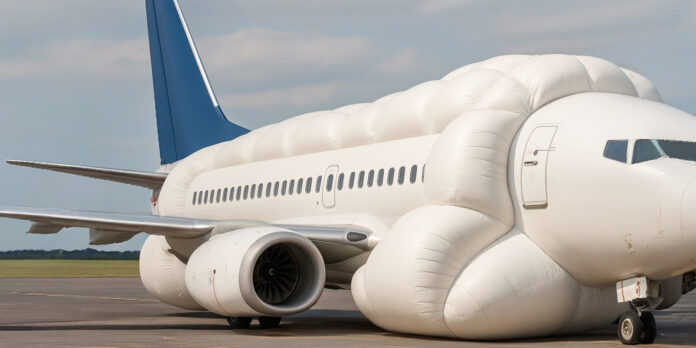A student-led concept from BITS Pilani, Dubai, is exploring how artificial intelligence and inflating external airbags could reduce the impact of airplane crashes. Named Project Rebirth, the idea is the work of Eshel Wasim and Dharsan Srinivasan, and it appears among the entries for The James Dyson Award 2025.
At its core, Project Rebirth uses a network of sensors and AI software to detect when a crash is imminent. If the system determines that a crash cannot be prevented, and the aircraft is flying below 3,000 feet, it automatically deploys high-speed external airbags around the plane. These airbags are positioned at the front, bottom, and rear of the fuselage, and are made from multi-layered materials intended to absorb impact. The designers say the airbags can inflate in under two seconds. Pilots retain the ability to manually stop deployment if necessary.
Before making the decision to activate, the AI system monitors multiple parameters, including engine status, speed, altitude, direction, temperature, and even pilot activity. “The design is based on three goals: slowing down the aircraft before it hits the ground, absorbing the force of the crash, and helping rescuers arrive quickly,” the team explains.
If the engines remain functional during the emergency, the system’s reverse thrust feature engages to slow the aircraft. In cases where the engines are not working, gas thrusters are triggered to reduce speed and stabilize the aircraft before landing.

The designers have also incorporated features to aid post-crash rescue operations. The concept proposes painting the aircraft in bright orange for visibility, and equipping it with infrared beacons, GPS trackers, and flashing lights. These measures would make the crash site easier to locate, helping rescue teams reach survivors faster.
Project Rebirth’s design draws on research from existing aviation and military safety systems, crash investigation reports, and studies of advanced materials like Kevlar, thermoplastic polyurethane (TPU), Zylon, and smart fluids. The team has already built a small-scale prototype, which includes sensors, carbon dioxide canisters, and microcontrollers. The AI software processes changes in speed, force, and vibration, and then initiates safety actions in sequence.
Initial computer simulations of the system suggest it could reduce crash impact by more than 60 percent. While these results are early and based on virtual testing, they form the basis for the team’s plans to collaborate with aircraft manufacturers and research labs. Future steps include building full-size prototypes and conducting trials in wind tunnels and crash simulations.

One advantage of the concept, according to the team, is its adaptability. Project Rebirth is designed to work with both new aircraft and those already in service, allowing airlines to retrofit their fleets with the system.
While still in the conceptual stage, Project Rebirth reflects ongoing interest in using AI and advanced materials to improve aviation safety. Whether it becomes a commercial reality will depend on further development, large-scale testing, and cooperation from the aviation industry.
Source: James Dyson Award



